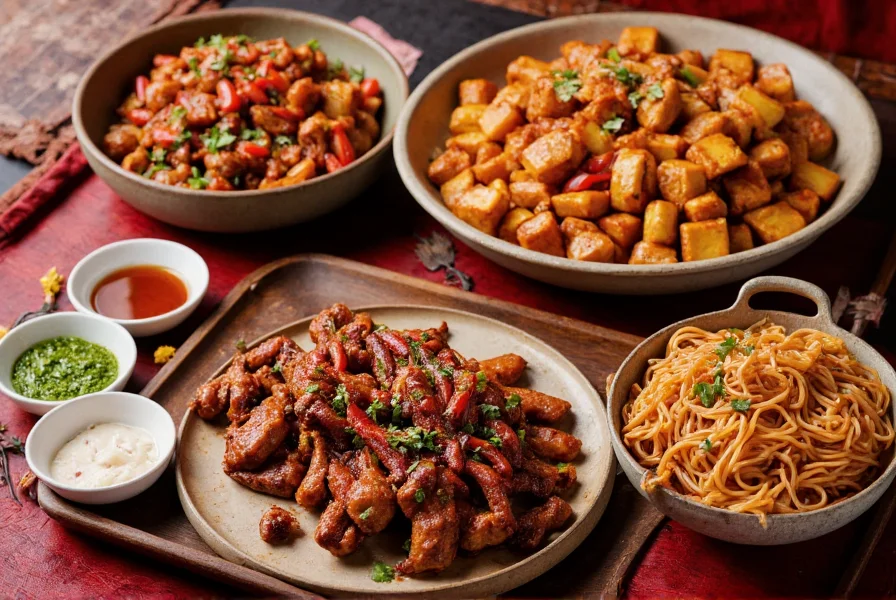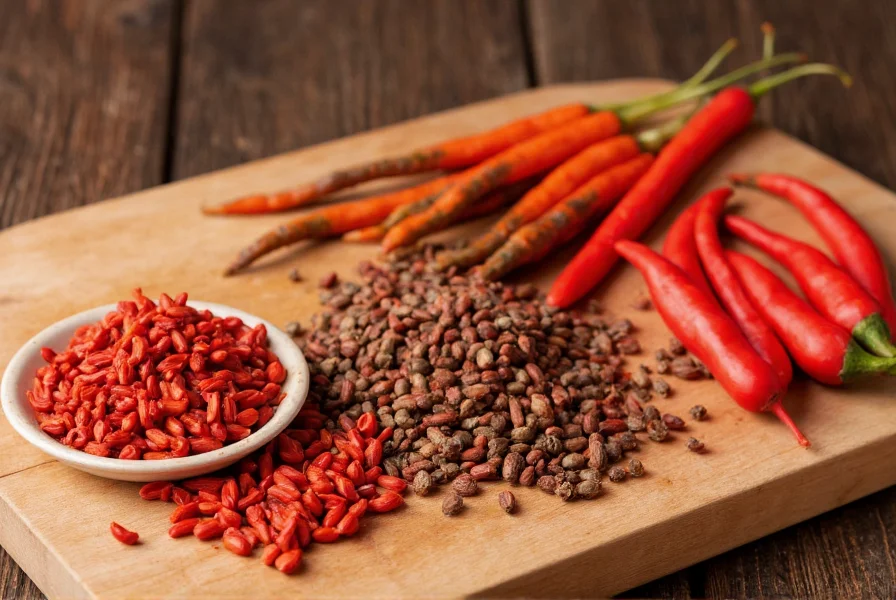When exploring Chinese cuisine, understanding a chili-focused menu opens doors to some of the most vibrant and flavorful dishes in Chinese cooking. Chinese restaurants often feature "chili menus" or spicy specialty sections highlighting regional specialties where chili peppers play a starring role, particularly from Sichuan and Hunan provinces known for their bold, spicy flavors.
Understanding Chinese Chili Cuisine Traditions
Chinese culinary tradition incorporates chili peppers differently across regions, with Sichuan and Hunan cuisines representing the most prominent spicy styles. While chili peppers weren't native to China (they arrived via trade routes in the 16th century), they've become integral to certain regional cooking styles. A dedicated authentic Chinese spicy dishes menu typically features:
- Sichuan style: Known for "mala" (numbing-spicy) flavor from Sichuan peppercorns combined with dried chilies
- Hunan style: Features fresh red chilies with straightforward heat and bold flavors
- Guizhou style: Incorporates fermented chili pastes and sour-spicy combinations
Common Dishes on a Chinese Chili Menu
When examining how to read Chinese restaurant chili menu offerings, you'll typically find these categories:
| Menu Category | Signature Dishes | Spice Characteristics |
|---|---|---|
| Appetizers | Spicy Cucumber Salad, Chili Oil Wontons, Sichuan Pickles | Moderate heat with aromatic chili oil |
| Main Courses | Mapo Tofu, Kung Pao Chicken, Fish-Flavored Pork | High heat with complex spice blends |
| Noodle/Rice Dishes | Dan Dan Noodles, Spicy Beef Noodles, Chao Shou | Varying heat levels, often customizable |
| Hot Pots | Sichuan Hot Pot, Yuanyang (Split-Pan) Hot Pot | Intense heat with customizable spice levels |
Decoding Spice Levels and Customization Options
Understanding Chinese restaurant menu with chili specialties requires knowing how spice levels typically work. Most authentic Chinese restaurants offer multiple heat levels:
- Mild: Suitable for beginners, minimal visible chilies
- Medium: Noticeable heat with some chili pieces visible
- Spicy: Significant heat with abundant dried or fresh chilies
- Sichuan Hot: Authentic regional heat level (not for the faint of heart)
- Hunan Fire: Direct, intense heat from fresh chilies
Many establishments allow customization of spice levels, though traditionalists argue certain dishes should be experienced at their authentic heat level to properly appreciate the flavor balance. When ordering from a popular Chinese chili dishes list, don't hesitate to ask your server about adjusting spice levels to match your tolerance.
Regional Variations in Chinese Chili Menus
A comprehensive spicy Chinese cuisine menu guide should recognize key regional differences:
Sichuan Cuisine features the famous "mala" sensation (numbing and spicy) created by Sichuan peppercorns combined with dried red chilies. Signature dishes include Mapo Tofu and Kung Pao Chicken, where the chili heat is balanced with complex flavors rather than pure spiciness.
Hunan Cuisine delivers straightforward heat using fresh red chilies, garlic, and shallots. Dishes like Steamed Fish Head with Chopped Chili showcase vibrant, direct spiciness without numbing elements.
Yunnan and Guizhou regions incorporate fermented chili pastes and often combine spicy elements with sour flavors, creating distinctive taste profiles different from the more famous Sichuan and Hunan styles.

Practical Ordering Tips for Chinese Chili Menus
Navigating a Chinese restaurant menu with chili specialties becomes easier with these practical tips:
- Start with one moderately spicy dish to gauge the restaurant's heat level
- Ask about the difference between "la" (spicy) and "ma la" (numbing-spicy) preparations
- Request rice or cucumber dishes to balance intense heat
- Look for dishes labeled "Sichuan style" or "Hunan style" for authentic regional preparations
- Don't assume all red sauces are extremely spicy—some use red ingredients for color without significant heat
Understanding these distinctions helps you make informed choices when presented with a what is on a typical Chinese chili menu selection. The best Chinese restaurants take pride in their chili preparations and will happily explain their spice levels and regional specialties.
Cultural Context of Chili in Chinese Cuisine
While chili peppers have become synonymous with certain Chinese regional cuisines, they're actually a relatively recent addition to Chinese cooking, having arrived from the Americas in the late 16th century. The integration of chilies transformed regional cooking styles, particularly in Sichuan province where the humid climate made the warming properties of chilies particularly valuable.
Today, a well-crafted Sichuan chili menu items explained represents centuries of culinary evolution where chili peppers have become essential flavor components rather than just heat sources. The best Chinese chili dishes balance heat with other flavor elements—sweet, sour, salty, and umami—to create complex, satisfying eating experiences.

Frequently Asked Questions
What's the difference between Sichuan and Hunan spicy dishes on a Chinese menu?
Sichuan dishes feature "mala" (numbing-spicy) flavor from Sichuan peppercorns combined with dried chilies, creating complex layered heat. Hunan cuisine uses fresh red chilies for direct, straightforward heat without numbing elements. Sichuan dishes often incorporate sweet and sour elements to balance the heat, while Hunan dishes emphasize pure spiciness with garlic and shallots.
How can I tell if a dish on a Chinese chili menu will be extremely spicy?
Look for specific indicators: dishes containing "la" (spicy), "ma la" (numbing-spicy), or "hong" (red) in their names often indicate significant heat. Menu descriptions mentioning "dried chilies," "chili oil," or "Sichuan peppercorns" typically signal spicier preparations. Restaurants often include chili pepper icons next to extremely spicy dishes, with more peppers indicating higher heat levels.
Are all red sauces on a Chinese chili menu extremely spicy?
No, not all red sauces indicate extreme spiciness. Some Chinese dishes use red ingredients like tomatoes, red yeast rice, or red cooking wine for color without significant heat. Dishes like Sweet and Sour Pork have red sauces but minimal spice. The presence of visible chili peppers, chili oil, or specific regional labels (Sichuan, Hunan) are better indicators of actual spiciness than sauce color alone.
Can I customize the spice level of dishes on a Chinese chili menu?
Most authentic Chinese restaurants allow spice level customization, though traditionalists may recommend experiencing certain dishes at their authentic heat level. When ordering, specify your preference using terms like "wei la" (not spicy), "shao la" (a little spicy), or "la" (spicy). Be aware that some dishes, particularly those featuring whole dried chilies, may have heat that intensifies as you eat, so proceed cautiously with unfamiliar dishes.
What are the most popular dishes on a typical Chinese chili menu?
The most popular dishes include Mapo Tofu (spicy tofu with minced meat), Kung Pao Chicken (wok-fried chicken with peanuts and chilies), Dan Dan Noodles (spicy noodle soup with minced pork), and Sichuan Hot Pot. Other favorites are Fish-Flavored Eggplant, Spicy Wontons, and Twice-Cooked Pork. These dishes represent the balance of heat, flavor, and texture that defines authentic Chinese spicy cuisine.










 浙公网安备
33010002000092号
浙公网安备
33010002000092号 浙B2-20120091-4
浙B2-20120091-4